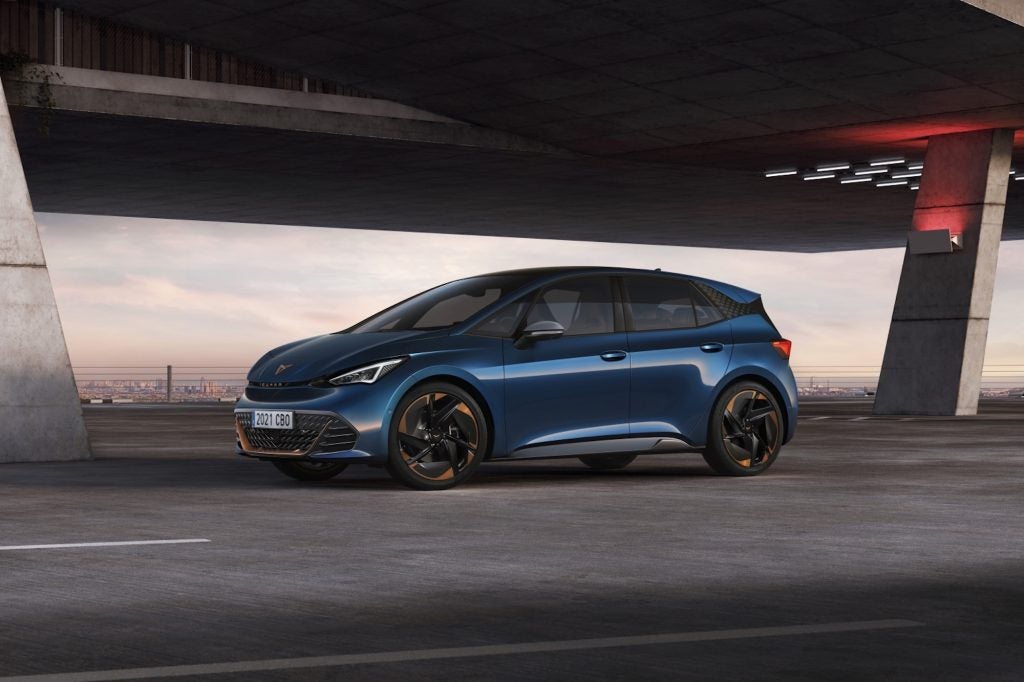Revealed eight years ago next month as a Seat and since 2018 as a Cupra too, the Ateca defies its age. This, thanks to good proportions and dapper detailing. The 4,381 mm long SUV shows what is possible when an OEM gets the basic package spot-on. Then updates it at regular intervals.
Why wouldn’t SEAT keep building this model when the entire concept – platform, engines, transmissions and a refreshingly old-style and therefore premium-feel Volkswagen Group interior – has such strong appeal?
Ateca pricing and margins are strong. Demand remains so too. This is especially good news as sales of EVs collapse across Europe for the second month in succession. Things are bad for such models in the UK but far worse in Germany, where deliveries crashed by 55 per cent year-on-year. Let’s not even mention the infamous one Tesla sold in South Korea during January.
Not an EV option in sight – so what?
There are no diesel, electric, hybrid or plug-in hybrid powertrains, the engine range consisting of three choices: a 221 kW (300 PS) top-spec 2.0-litre engine plus a new 140 kW (190 PS) unit of the same capacity and a 110 kW (150 PS) 1.5-litre alternative. On the surface that shouldn’t mean much success. Yet we must remember there are a large number of people who want a car powered by petrol, from a swish and sporty brand.
Three engines and two traction systems
How well do you really know your competitors?
Access the most comprehensive Company Profiles on the market, powered by GlobalData. Save hours of research. Gain competitive edge.

Thank you!
Your download email will arrive shortly
Not ready to buy yet? Download a free sample
We are confident about the unique quality of our Company Profiles. However, we want you to make the most beneficial decision for your business, so we offer a free sample that you can download by submitting the below form
By GlobalDataTwo-axle traction which carries 4Drive branding is reserved for the top two engines, while the 1.5 sends its torque solely to the front tyres via one of the Volkswagen Group’s own seven-ratio DSGs. TSI badging (turbocharged petrol) applies in each case.
This was the first model for Cupra as its own division of SEAT S.A. Over the years there have been a fair few tweaks made, though none terribly dramatic. This remains so, with the new powertrains joined by adjustments to trim levels. And there is just the one exterior change, that being a new rear diffuser.
New engine brings the power
It remains an engaging vehicle for keen drivers, especially with the latest 140 kW 2.0-litre turbo. Wheel-spin is simply non-existent and that included occasionally heavy rain during my week with the car.
Driving the Ateca proves this is a genuinely good choice for those who want something fun for the owner, yet with lots of practicality. The engine sounds as terrific as all the wonderful Volkswagen touches which we used to appreciate in the Group’s now older vehicles. Imagine that the Ateca by merely remaining largely as it was in 2016, has become so much more desirable than most Audis, not to mention VWs.
All the better for being far from new
Grab a door handle and you immediately think, “This will never become loose, let alone break“. The ones on the inside if anything feel even more solid and their action is precision itself. Twist or pull or turn any control and it is the 2010s all over again. Back when you sat in any VAG model and realised it was worth the high price. Or heard the mirrors fold with the most delightful whirring noise, touched a rubber-surfaced vent control and listened to it click open or closed.
Small things have huge appeal in this Cupra. They add up and are much-missed in almost all 2024-style Volkswagen Group cars and LCVs. Don’t believe me? Twiddle the floppy-slippery mirrors dial of a fifty thousand plus ID.7 then try the one in the Ateca. Or thrill to the quiet ratcheting of the cubby box lid as it is raised or lowered. Then when 4×4 drive is needed, turn the dial marked with COMFORT, SPORT, INDIVIDUAL, OFFROAD and SNOW choices. Each moment of contact a tactile treat. The sense of obsessively first-rate engineering is everywhere.
Want to warm your hands? Tap a button on the steering wheel. Simple. Or how about activating the fog lamps? Why remove your eyes from the road and try to fathom a touch-pad when you instead twist and turn and pull and push. It’s like being in a Mercedes-Benz before all the great stuff was junked in the name of flashy-bongy-chimey-beepy-I-demand-your-attention supposed progress. I could have kept this Cupra forever it is such a lovely thing to drive and look at and be in control of.
On the outside, there are copper-coloured trim pieces here and there to match the equally subtle ones inside. Such as the stitching around the steering wheel. The word CUPRA appears at the base of the tailgate, while the logo is up front on the grille. Nowhere could I find the word SEAT either; not even on the engine cover or etched into any piece of glass. The company is clearly serious about this being a true fancy-pants brand.
Conclusion
Is the Ateca the best Cupra in the range? I think it just might be, and this is quite the compliment – the other models are all very good in their own ways yet could do with dashboards where the tech exists but isn’t front and centre. Anyone else seeing what keeps happening to Mercedes sales, especially in the UK? In January BMW sold almost twice as many vehicles. The latest Benzes are very good cars, yes, and the choice of models is vast. But many are turned off by the constant son et lumière show that never leaves you alone.
Who would have thought that an eight-year old SEAT-derived SUV has vastly more appeal than so very many German luxury brand cars?
The as-tested Cupra Ateca 2.0 Eco TSI 190PS 4Drive DSG is priced from GBP41,610. WLTP Combined economy is 33.6-35.3 mpg, CO2 is 183 g/km, 0-62 takes a claimed 7.2 seconds and top speed is stated as 132 mph. Boot capacity is 485 l and kerb weight is 1,580 kg. The Ateca range starts at GBP36,045.
Cupra sales surge but SEAT still strong
Revisions for the Ateca will have played a modest but worthwhile role in the brand’s successes during the final quarter of 2023, Cupra sales surging by 51 per cent worldwide to a record 230,700.
What looks like a planned decline for SEAT – no EVs, no new models – mean that this is rapidly becoming the junior brand of the Martorell-based OEM’s two marques. Last year, the pairing delivered 519,200 vehicles but in December, Acea data show SEAT’s lead being fewer than 700 cars (20,135 versus 19,443) for the combined EU-EFTA-UK markets.
Surely it won’t be long until Cupra, thanks also to the successes of its new and freshened line-up, overtakes the SEAT brand.
Interestingly, Cupra trails its master by quite some margin in Britain; not that the more upscale division isn’t doing very well here (the UK is the number two market with Germany number one). Last year’s comparative totals of 32,177 and 25,658 fail to show how Cupra’s numbers surged by 78 per cent year-on-year. The Born was a big factor, SEAT having no equivalent of the little EV. We therefore may not see a switch in the pecking order during 2024. However, considering the enormous disruptions of recent years, any prediction is almost meaningless.
What will happen to SEAT?
SEAT is expected to steadily become the Volkswagen Group’s equivalent of Dacia, MG or Suzuki, at least in Europe (and not, as some believe, a so-called ‘Mobility’ brand). That might happen as each of the current models is facelifted and rebooted as a more affordable vehicle lacking the newest technology. There is certainly a ready market for such cars and the Spanish marque could thrive thanks to the German-engineered feel of each model.
What we know is officially coming next from Cupra includes the Terramar (electrified SUV to be made in Hungary), Tavascan (electric SUV-coupé), Born VZ plus facelifts for the León and Formentor, all in 2024. Then after a relatively quiet 2025, another additional EV should land right at the end of that year: the Raval, a B segment model to supplement the Born.



